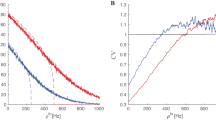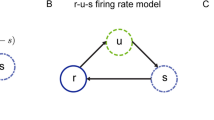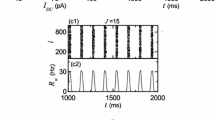Abstract
The Fast Spiking (FS) interneurons are coupled by both electrical and inhibitory synapses and experimental findings suggest that they operate as a clockwork affecting the processing of neural information. At present, it is not known which is the functional role of electrical synapses in a network of inhibitory interneurons. In our contribution, by using a single compartment biophysical model of an FS cell, we determine the parameter values leading to the emergence of synchronous regimes in a network of FS interneurons coupled by chemical and electrical synapses. We also compare our results with those recently obtained for a pair of coupled Integrate & Fire neural models [1].
Preview
Unable to display preview. Download preview PDF.
Similar content being viewed by others
References
Lewis, T., Rinzel, J.: Dynamics of spiking neurons connected by both inhibitory and electrical coupling. J. Comp. Neuroscience 14, 283–309 (2003)
Galarreta, M., Hestrin, S.: Electrical synapses between GABA-releasing interneurons. Nat. Neurosci. 2, 425–433 (2001)
Di Garbo, A., Barbi, M., Chillemi, S.: Synchronization in a network of fast-spiking interneurons. BioSystems 67, 45–53 (2002)
Van Vreeswijk, C.A., Abbott, L.F., Ermentrout, G.B.: Inhibition, not excitation, synchronizes coupled neurons. J. Comp. Neurosci. 1, 303–313 (1995)
Wang, X.J., Rinzel, J.: Alternating and synchronous rhythms in reciprocally inhibitory model neurons. Neural Comput. 4, 84–97 (1992)
Wang, X.J., Buzsaki, G.: Gamma oscillations by synaptic inhibition in an interneuronal network model. J. Neurosci. 16, 6402–6413 (1996)
Whittington, M.A., Traub, R.D., Jefferys, J.G.R.: Synchronized oscillations in interneuron networks driven by metabotropic glutamate receptor activation. Nature 373, 612–615 (1995)
Whittington, M.A., Traub, R.D., Kopell, N., Ermentrout, B., Buhl, E.H.: Inhibition-based rhythms: experimental and mathematical observations on network dynamics. Int. J. Psychophysio. 38, 315–336 (2001)
Galarreta, M., Hestrin, S.: A network of fast-spiking cells in the cortex connected by electrical synapses. Nature 402, 72–75 (1999)
Gibson, J.R., Beierlein, M., Connors, B.W.: Two networks of electrically coupled inhibitory neurons in neocortex. Nature 402, 75–79 (1999)
Erisir, A., Lau, D., Rudy, B., Leonard, C.S.: Function of specific K + channels in sustained high-frequency firing of fast-spiking neocortical interneurons. J. Neurophysiology 82, 2476–2489 (1999)
Galarreta, M., Hestrin, S.: Electrical and chemical Synapses among parvalbumin fast-spiking GABAergic interneurons in adult mouse neocortex. PNAS USA 99, 12438–12443 (2002)
Rinzel, J., Ermentrout, B.: Analysis of neural excitability and oscillations. In: Koch, Segev (eds.) Methods in neural modelling. The MIT Press, Cambridge (1989)
Martina, M., Jonas, P.: Functional differences in Na + channel gating between fast spiking in-terneurons and principal neurons of rat hippocampus. J. of Physiol. 505.3, 593–603 (1997)
Coetzee, W.A., et al.: Molecular diversity of K+ channels. Annals of the New York Academy of Sciences 868, 233–285 (1999)
Lien, C.C., Jonas, P.: Kv3 potassium conductance is necessary and kinetically optimized for high-frequency action potential generation in hippocampal interneurons. J. of Neurosci. 23, 2058–2068 (2003)
Ermentrout, B.: Neural networks as spatio-temporal pattern-forming systems. Rep. Prog. Phys. 61, 353–430 (1998)
Author information
Authors and Affiliations
Editor information
Editors and Affiliations
Rights and permissions
Copyright information
© 2005 Springer-Verlag Berlin Heidelberg
About this paper
Cite this paper
Di Garbo, A., Panarese, A., Barbi, M., Chillemi, S. (2005). The After-Hyperpolarization Amplitude and the Rise Time Constant of IPSC Affect the Synchronization Properties of Networks of Inhibitory Interneurons. In: Cabestany, J., Prieto, A., Sandoval, F. (eds) Computational Intelligence and Bioinspired Systems. IWANN 2005. Lecture Notes in Computer Science, vol 3512. Springer, Berlin, Heidelberg. https://doi.org/10.1007/11494669_15
Download citation
DOI: https://doi.org/10.1007/11494669_15
Publisher Name: Springer, Berlin, Heidelberg
Print ISBN: 978-3-540-26208-4
Online ISBN: 978-3-540-32106-4
eBook Packages: Computer ScienceComputer Science (R0)




